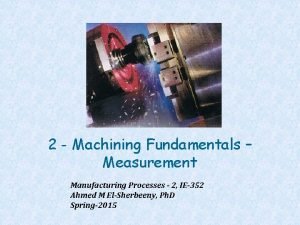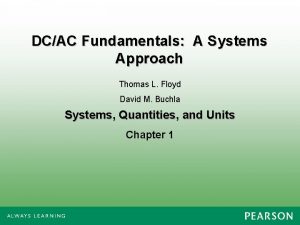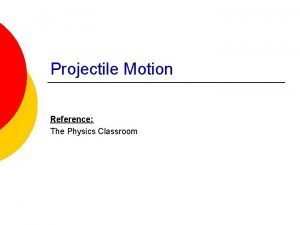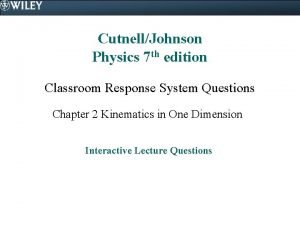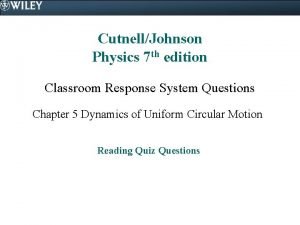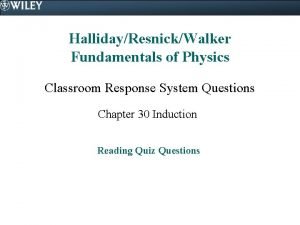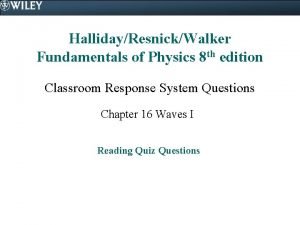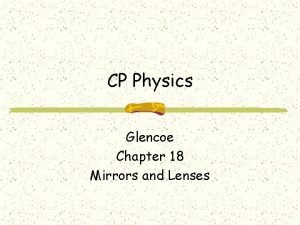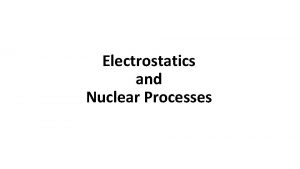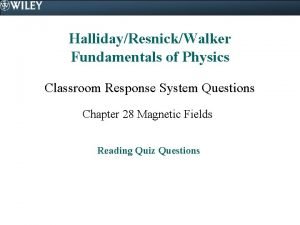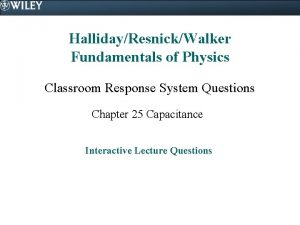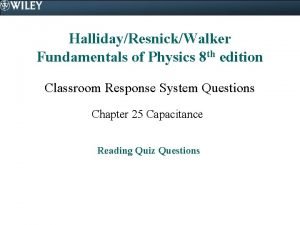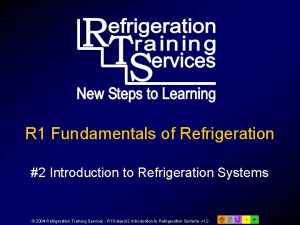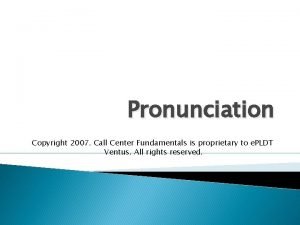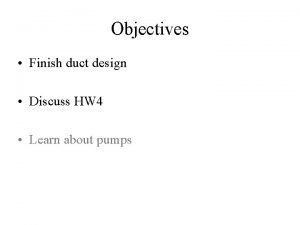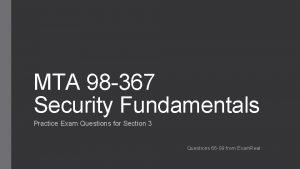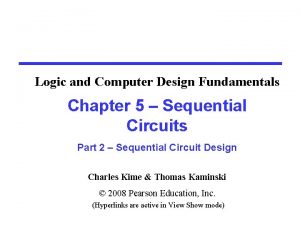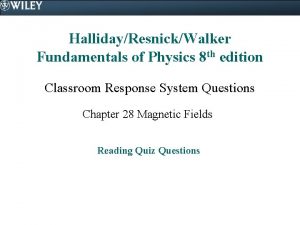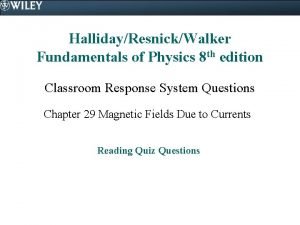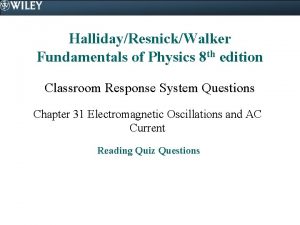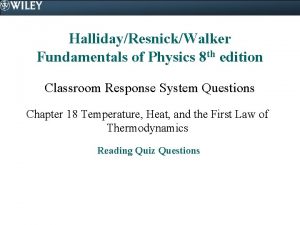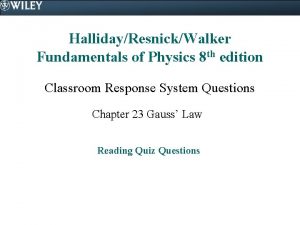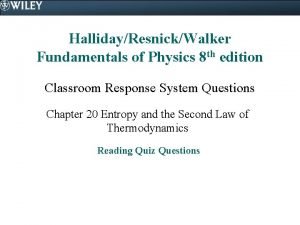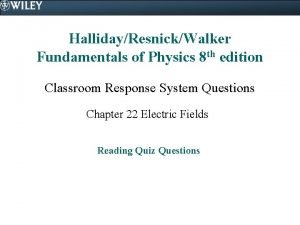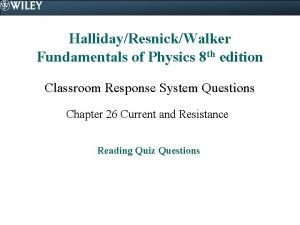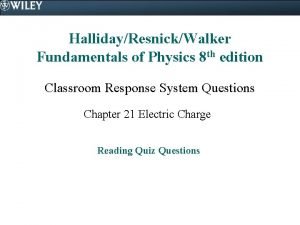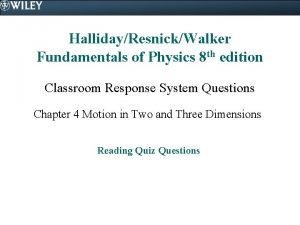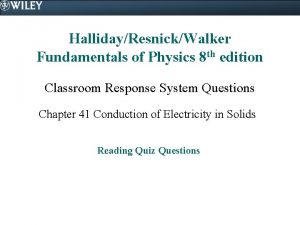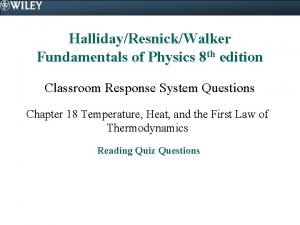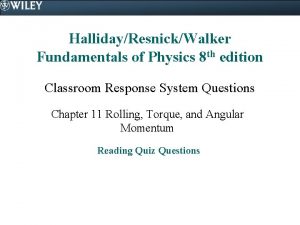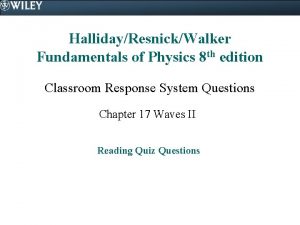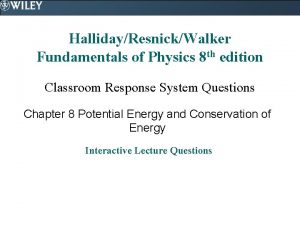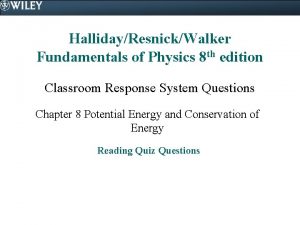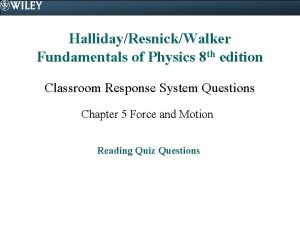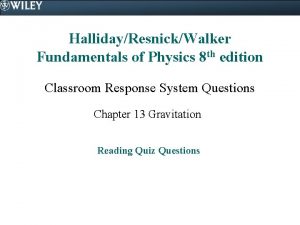HallidayResnickWalker Fundamentals of Physics 8 th edition Classroom

























































- Slides: 57

Halliday/Resnick/Walker Fundamentals of Physics 8 th edition Classroom Response System Questions Chapter 3 Vectors Reading Quiz Questions

3. 2. 1. Which of the following parameters, if any, is not a vector? a) acceleration b) displacement c) average velocity d) all are vectors e) none are vectors

3. 2. 1. Which of the following parameters, if any, is not a vector? a) acceleration b) displacement c) average velocity d) all are vectors e) none are vectors

3. 2. 2. Which of the following parameters, if any, is not a scalar quantity? a) temperature b) distance c) average speed d) instantaneous velocity e) all are scalars

3. 2. 2. Which of the following parameters, if any, is not a scalar quantity? a) temperature b) distance c) average speed d) instantaneous velocity e) all are scalars

3. 2. 3. Which one of the following statements is true concerning scalar quantities? a) Scalar quantities have both magnitude and direction. b) Scalar quantities must be represented by base units. c) Scalar quantities can be added to vector quantities using rules of trigonometry. d) Scalar quantities can be added to other scalar quantities using rules of trigonometry. e) Scalar quantities can be added to other scalar quantities using rules of ordinary addition.

3. 2. 3. Which one of the following statements is true concerning scalar quantities? a) Scalar quantities have both magnitude and direction. b) Scalar quantities must be represented by base units. c) Scalar quantities can be added to vector quantities using rules of trigonometry. d) Scalar quantities can be added to other scalar quantities using rules of trigonometry. e) Scalar quantities can be added to other scalar quantities using rules of ordinary addition.

3. 2. 4. Which one of the following quantities is a vector quantity? a) the age of the pyramids in Egypt b) the mass of a watermelon c) the sun's pull on the earth d) the number of people on board an airplane e) the temperature of molten lava

3. 2. 4. Which one of the following quantities is a vector quantity? a) the age of the pyramids in Egypt b) the mass of a watermelon c) the sun's pull on the earth d) the number of people on board an airplane e) the temperature of molten lava

3. 2. 5. Which one of the following situations involves a vector quantity? a) The velocity of the rocket was 325 m/s, due east. b) The overnight low temperature in Toronto was 4. 0 C. c) The volume of the soft drink can is 0. 360 liters. d) The mass of the Martian soil probe was 250 kg. e) The light took approximately 500 s to travel from the sun to the earth.

3. 2. 5. Which one of the following situations involves a vector quantity? a) The velocity of the rocket was 325 m/s, due east. b) The overnight low temperature in Toronto was 4. 0 C. c) The volume of the soft drink can is 0. 360 liters. d) The mass of the Martian soil probe was 250 kg. e) The light took approximately 500 s to travel from the sun to the earth.

3. 2. 6. A vector is represented by an arrow. What is the significance of the length of the arrow? a) Long arrows represent velocities and short arrows represent forces. b) The length of the arrow is proportional to the magnitude of the vector. c) Short arrows represent accelerations and long arrows represent velocities. d) The length of the arrow indicates its direction. e) There is no significance to the length of the arrow.

3. 2. 6. A vector is represented by an arrow. What is the significance of the length of the arrow? a) Long arrows represent velocities and short arrows represent forces. b) The length of the arrow is proportional to the magnitude of the vector. c) Short arrows represent accelerations and long arrows represent velocities. d) The length of the arrow indicates its direction. e) There is no significance to the length of the arrow.

3. 3. 1. Consider the two vectors represented in the drawing. Which of the following options is the correct way to add graphically vectors and ?

3. 3. 1. Consider the two vectors represented in the drawing. Which of the following options is the correct way to add graphically vectors and ?

3. 3. 2. Consider the two vectors represented in the drawing. Which of the following options is the correct way to subtract graphically vectors and ?

3. 3. 2. Consider the two vectors represented in the drawing. Which of the following options is the correct way to subtract graphically vectors and ?

3. 3. 3. The horizontal and vertical components of vector are and , respectively. Which one of the following statements concerning the sum of the magnitudes of the two component vectors is true? a) vx + vx = 0 b) The sum of the magnitudes of the two components is greater than the magnitude of. c) The sum of the magnitudes of the two components is less than the magnitude of. d) The sum of the magnitudes of the two components is equal to the magnitude of. e) The sum of the magnitudes of the two components is less than or equal to magnitude of.

3. 3. 3. The horizontal and vertical components of vector are and , respectively. Which one of the following statements concerning the sum of the magnitudes of the two component vectors is true? a) vx + vx = 0 b) The sum of the magnitudes of the two components is greater than the magnitude of. c) The sum of the magnitudes of the two components is less than the magnitude of. d) The sum of the magnitudes of the two components is equal to the magnitude of. e) The sum of the magnitudes of the two components is less than or equal to magnitude of.

3. 3. 4. The horizontal and vertical components of vector are and , respectively. Which one of the following statements concerning the vector sum of the two component vectors is true? a) The sum of the magnitudes of the two components is greater than the magnitude of. b) The vector sum of the two components is greater than the magnitude of . c) The vector sum of the two components is less than the magnitude of. d) The vector sum of the two components is equal to the magnitude of. e) The vector sum of the two components is less than or equal to the magnitude of.

3. 3. 4. The horizontal and vertical components of vector are and , respectively. Which one of the following statements concerning the vector sum of the two component vectors is true? a) The sum of the magnitudes of the two components is greater than the magnitude of. b) The vector sum of the two components is greater than the magnitude of . c) The vector sum of the two components is less than the magnitude of. d) The vector sum of the two components is equal to the magnitude of. e) The vector sum of the two components is less than or equal to the magnitude of.

3. 4. 1. Which one of the following statements concerning vectors and scalars is false? a) In calculations, the vector components of a vector may be used in place of the vector itself. b) It is possible to use vector components that are not perpendicular. c) A scalar component may be either positive or negative. d) A vector that is zero may have components other than zero. e) Two vectors are equal only if they have the same magnitude and direction.

3. 4. 1. Which one of the following statements concerning vectors and scalars is false? a) In calculations, the vector components of a vector may be used in place of the vector itself. b) It is possible to use vector components that are not perpendicular. c) A scalar component may be either positive or negative. d) A vector that is zero may have components other than zero. e) Two vectors are equal only if they have the same magnitude and direction.

3. 4. 2. , , and, are three vectors. Vectors and when added together equal the vector. In mathematical form, . Which one of the following statements concerning the components of vectors and must be true if Ay = 0? a) The y components of vectors and are both equal to zero. b) The y components of vectors and when added together equal zero. c) By Cy = 0 or Cy By = 0 d) Either answer (a) or answer (b) is correct, but never both. e) Either answer (a) or answer (b) is correct. It is also possible that both are correct.

3. 4. 2. , , and, are three vectors. Vectors and when added together equal the vector. In mathematical form, . Which one of the following statements concerning the components of vectors and must be true if Ay = 0? a) The y components of vectors and are both equal to zero. b) The y components of vectors and when added together equal zero. c) By Cy = 0 or Cy By = 0 d) Either answer (a) or answer (b) is correct, but never both. e) Either answer (a) or answer (b) is correct. It is also possible that both are correct.

3. 4. 3. Vector has a magnitude of 88 km/h and is directed at 25 relative to the x axis. Which of the following choices indicates the horizontal and vertical components of vector ? rx ry a) +22 km/h +66 km/h b) +39 km/h +79 km/h c) +79 km/h +39 km/h d) +66 km/h +22 km/h e) +72 km/h +48 km/h

3. 4. 3. Vector has a magnitude of 88 km/h and is directed at 25 relative to the x axis. Which of the following choices indicates the horizontal and vertical components of vector ? rx ry a) +22 km/h +66 km/h b) +39 km/h +79 km/h c) +79 km/h +39 km/h d) +66 km/h +22 km/h e) +72 km/h +48 km/h

3. 4. 4. Vector has components ax = 15. 0 and ay = 9. 0. What is the approximate magnitude of vector ? a) 12. 0 b) 24. 0 c) 10. 9 d) 6. 87 e) 17. 5

3. 4. 4. Vector has components ax = 15. 0 and ay = 9. 0. What is the approximate magnitude of vector ? a) 12. 0 b) 24. 0 c) 10. 9 d) 6. 87 e) 17. 5

3. 4. 5. Vector has a horizontal component ax = 15. 0 m and makes an angle = 38. 0 with respect to the positive x direction. What is the magnitude of ay, the vertical component of vector ? a) 4. 46 m b) 4. 65 m c) 5. 02 m d) 7. 97 m e) 14. 3 m

3. 4. 5. Vector has a horizontal component ax = 15. 0 m and makes an angle = 38. 0 with respect to the positive x direction. What is the magnitude of ay, the vertical component of vector ? a) 4. 46 m b) 4. 65 m c) 5. 02 m d) 7. 97 m e) 14. 3 m

3. 5. 1. Which one of the following statements concerning unit vectors is true? a) The magnitude of a unit vector is always equal to 1. b) A unit vector always points in the direction of motion. c) The magnitude of a unit vector sometimes equals zero. d) A unit vector depends on the units of measurement used and is a method for tracking the units throughout a calculation. e) Unit vectors are predominantly used in mathematics, but seldom used in physics.

3. 5. 1. Which one of the following statements concerning unit vectors is true? a) The magnitude of a unit vector is always equal to 1. b) A unit vector always points in the direction of motion. c) The magnitude of a unit vector sometimes equals zero. d) A unit vector depends on the units of measurement used and is a method for tracking the units throughout a calculation. e) Unit vectors are predominantly used in mathematics, but seldom used in physics.

3. 5. 2. A delivery truck leaves a warehouse and travels 2. 60 km north. The truck makes a right turn and travels 1. 33 km east before making another right turn and then travels 1. 45 km south to arrive at its destination. Express the displacement of the truck from the warehouse using unit vectors, where north is the direction and east is the direction. a) b) c) d) e)

3. 5. 2. A delivery truck leaves a warehouse and travels 2. 60 km north. The truck makes a right turn and travels 1. 33 km east before making another right turn and then travels 1. 45 km south to arrive at its destination. Express the displacement of the truck from the warehouse using unit vectors, where north is the direction and east is the direction. a) b) c) d) e)

3. 6. 1. Vector has scalar components Ax = 35 m/s and Ay = 15 m/s. Vector has scalar components Bx = 22 m/s and By = 18 m/s. Determine the scalar components of vector. Cx a) 13 m/s Cy 3 m/s b) 57 m/s 33 m/s c) 13 m/s 33 m/s d) 57 m/s 3 m/s e) 57 m/s 3 m/s

3. 6. 1. Vector has scalar components Ax = 35 m/s and Ay = 15 m/s. Vector has scalar components Bx = 22 m/s and By = 18 m/s. Determine the scalar components of vector. Cx a) 13 m/s Cy 3 m/s b) 57 m/s 33 m/s c) 13 m/s 33 m/s d) 57 m/s 3 m/s e) 57 m/s 3 m/s

3. 6. 2. Vector and vector that results from the operation a) b) c) d) e) Determine the.

3. 6. 2. Vector and vector that results from the operation a) b) c) d) e) Determine the.

3. 7. 1. How are the unit vectors chosen for a given coordinate system? a) The unit vectors are always chosen using the six common directions of north, east, south, west, upward, and downward. b) The unit vectors are always chosen to represent the directions with respect to a printed page with the directions, left, right, upward, downward, into the page, and out of the page. c) The unit vectors are chosen in any convenient manner because the relations of vectors are not dependent on the choice of the origin or the orientation of the axes, which are perpendicular to one another. d) The unit vectors are chosen in any convenient manner, regardless of the orientation of the unit vectors with respect to one another.

3. 7. 1. How are the unit vectors chosen for a given coordinate system? a) The unit vectors are always chosen using the six common directions of north, east, south, west, upward, and downward. b) The unit vectors are always chosen to represent the directions with respect to a printed page with the directions, left, right, upward, downward, into the page, and out of the page. c) The unit vectors are chosen in any convenient manner because the relations of vectors are not dependent on the choice of the origin or the orientation of the axes, which are perpendicular to one another. d) The unit vectors are chosen in any convenient manner, regardless of the orientation of the unit vectors with respect to one another.

3. 8. 1. Which of the following statements concerning the multiplication of a vector by a scalar is true? a) A vector cannot be mathematically multiplied by a scalar. b) When a vector is multiplied by a scalar, the result is a scalar product. c) When a vector is multiplied by a scalar, the result is a vector product. d) When a vector is multiplied by a scalar, the result is a vector that is perpendicular to the original vector. e) When a vector is multiplied by a scalar, the result is a vector that is parallel to the original vector.

3. 8. 1. Which of the following statements concerning the multiplication of a vector by a scalar is true? a) A vector cannot be mathematically multiplied by a scalar. b) When a vector is multiplied by a scalar, the result is a scalar product. c) When a vector is multiplied by a scalar, the result is a vector product. d) When a vector is multiplied by a scalar, the result is a vector that is perpendicular to the original vector. e) When a vector is multiplied by a scalar, the result is a vector that is parallel to the original vector.

3. 8. 2. Which of the following statements concerning the multiplication of a vector by a number n < 1 is true? a) A vector cannot be mathematically multiplied by a scalar. b) The result is a vector that is larger than the original vector and oppositely directed. c) The result is a vector that is smaller than the original vector and oppositely directed. d) The result is a vector that is larger than the original vector and rotated by 90 counterclockwise. e) The result is a vector that is smaller than the original vector and rotated by 90 counterclockwise.

3. 8. 2. Which of the following statements concerning the multiplication of a vector by a number n < 1 is true? a) A vector cannot be mathematically multiplied by a scalar. b) The result is a vector that is larger than the original vector and oppositely directed. c) The result is a vector that is smaller than the original vector and oppositely directed. d) The result is a vector that is larger than the original vector and rotated by 90 counterclockwise. e) The result is a vector that is smaller than the original vector and rotated by 90 counterclockwise.

3. 8. 3. In which of the following situations does the scalar product of two vectors have the largest value? a) The vectors are perpendicular to each other. b) The angle between the two vectors is forty five degrees. c) The angle between the two vectors is sixty degrees. d) The angle between the two vectors is zero degrees. e) The angle between the two vectors is ninety degrees.

3. 8. 3. In which of the following situations does the scalar product of two vectors have the largest value? a) The vectors are perpendicular to each other. b) The angle between the two vectors is forty five degrees. c) The angle between the two vectors is sixty degrees. d) The angle between the two vectors is zero degrees. e) The angle between the two vectors is ninety degrees.

3. 8. 5. In which of the following situations does the magnitude of the vector product of two vectors have the largest value? a) The vectors are parallel with each other. b) The angle between the two vectors is forty five degrees. c) The angle between the two vectors is sixty degrees. d) The angle between the two vectors is zero degrees. e) The angle between the two vectors is ninety degrees.

3. 8. 5. In which of the following situations does the magnitude of the vector product of two vectors have the largest value? a) The vectors are parallel with each other. b) The angle between the two vectors is forty five degrees. c) The angle between the two vectors is sixty degrees. d) The angle between the two vectors is zero degrees. e) The angle between the two vectors is ninety degrees.

3. 8. 6. and are vectors. Vector is directed due west and vector is directed due north. Which of the following choices correctly indicates the directions of vectors and ? a) is directed due west and is directed due north b) is directed due west and is directed due south c) is directed due east and is directed due south d) is directed due east and is directed due north e) is directed due north and is directed due west

3. 8. 6. and are vectors. Vector is directed due west and vector is directed due north. Which of the following choices correctly indicates the directions of vectors and ? a) is directed due west and is directed due north b) is directed due west and is directed due south c) is directed due east and is directed due south d) is directed due east and is directed due north e) is directed due north and is directed due west

3. 8. 7. Vectors and have different magnitudes and directions. Which of the following vector operations does not result in a vector? a) b) c) d) e)

3. 8. 7. Vectors and have different magnitudes and directions. Which of the following vector operations does not result in a vector? a) b) c) d) e)

3. 8. 8. Vector is directed due north. Vector is directed due east. Determine the direction of the vector product, . a) due south b) due west c) vertically downward d) vertically upward e) 45 north of east

3. 8. 8. Vector is directed due north. Vector is directed due east. Determine the direction of the vector product, . a) due south b) due west c) vertically downward d) vertically upward e) 45 north of east

3. 8. 9. Under what conditions does a) This situation never occurs. b) This occurs when the two vectors have the same magnitude. c) This occurs when the two vectors are perpendicular to one another. d) This occurs when the two vectors are parallel to one another. e) This always occurs, regardless of the particular vectors involved.

3. 8. 9. Under what conditions does a) This situation never occurs. b) This occurs when the two vectors have the same magnitude. c) This occurs when the two vectors are perpendicular to one another. d) This occurs when the two vectors are parallel to one another. e) This always occurs, regardless of the particular vectors involved.
 University physics with modern physics fifteenth edition
University physics with modern physics fifteenth edition Fundamentals of information systems 9th edition
Fundamentals of information systems 9th edition Fundamentals of information systems 9th edition
Fundamentals of information systems 9th edition Fluid mechanics fundamentals and applications
Fluid mechanics fundamentals and applications Thomas l floyd digital fundamentals 10th edition
Thomas l floyd digital fundamentals 10th edition Machining fundamentals 10th edition
Machining fundamentals 10th edition Fundamentals of organizational communication
Fundamentals of organizational communication Fundamentals of organizational communication 9th edition
Fundamentals of organizational communication 9th edition Fundamentals of corporate finance 3rd canadian edition
Fundamentals of corporate finance 3rd canadian edition Digital fundamentals 10th edition
Digital fundamentals 10th edition Floyd digital fundamentals 10th edition pdf
Floyd digital fundamentals 10th edition pdf Dc/ac fundamentals a systems approach
Dc/ac fundamentals a systems approach Computer security fundamentals 4th edition
Computer security fundamentals 4th edition Management fundamentals 8th edition
Management fundamentals 8th edition Fundamentals of information systems
Fundamentals of information systems Fundamentals of corporate finance canadian edition
Fundamentals of corporate finance canadian edition Fundamentals of corporate finance fifth edition
Fundamentals of corporate finance fifth edition Corporate finance 6th edition
Corporate finance 6th edition Fundamentals of abnormal psychology ninth edition
Fundamentals of abnormal psychology ninth edition Fundamentals of information systems 9th edition
Fundamentals of information systems 9th edition Thermal resistance formula
Thermal resistance formula The fundamentals of political science research 2nd edition
The fundamentals of political science research 2nd edition Btech smart classes
Btech smart classes Using mis 10th edition
Using mis 10th edition Zulily case study
Zulily case study Physics classroom projectile motion
Physics classroom projectile motion Physics classroom
Physics classroom Centripetal acceleration physics classroom
Centripetal acceleration physics classroom Hanging sign problem physics
Hanging sign problem physics Physics classroom
Physics classroom Circular functions
Circular functions Physics classroom lenses and mirrors
Physics classroom lenses and mirrors Physics classroom electrostatics
Physics classroom electrostatics Gauss law physics classroom
Gauss law physics classroom Physics classroom magnetic field
Physics classroom magnetic field Capacitance physics classroom
Capacitance physics classroom Physics classroom kinetic energy
Physics classroom kinetic energy Farad equivalent units
Farad equivalent units College physics explore and apply 2nd edition answers
College physics explore and apply 2nd edition answers Why does it happen
Why does it happen Ia physics ideas
Ia physics ideas Hotel industry analytics
Hotel industry analytics Water treatment fundamentals
Water treatment fundamentals Take charge today the fundamentals of investing
Take charge today the fundamentals of investing E commerce fundamentals
E commerce fundamentals Basic networking fundamentals
Basic networking fundamentals Security guide to network security fundamentals
Security guide to network security fundamentals Real estate financial analysis
Real estate financial analysis Solid based rapid prototyping
Solid based rapid prototyping Fundamentals of refrigeration
Fundamentals of refrigeration Call center fundamentals
Call center fundamentals Jos van winsen
Jos van winsen Hw
Hw Networking fundamentals
Networking fundamentals Security fundamentals practice test
Security fundamentals practice test Mpls fundamentals
Mpls fundamentals Esp trend lab
Esp trend lab Logic and computer design fundamentals
Logic and computer design fundamentals





